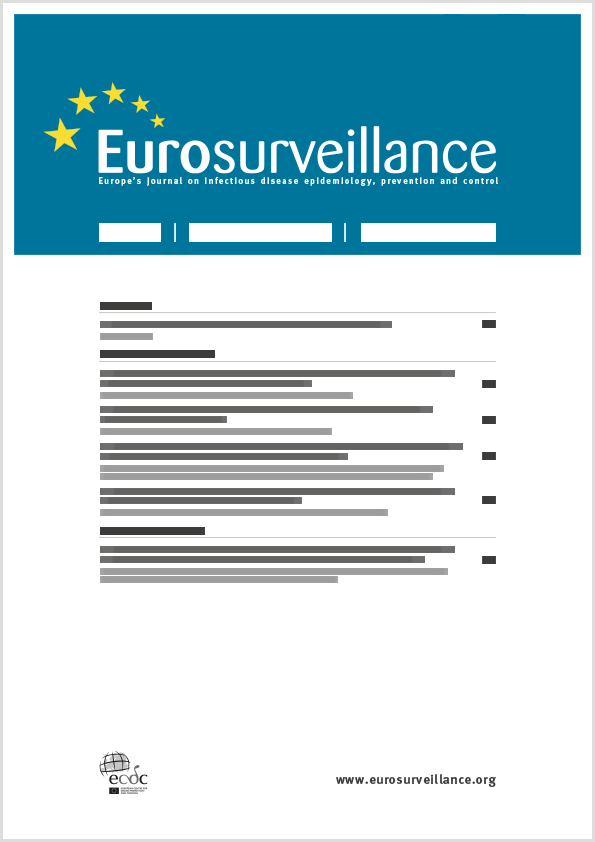- Home
- Eurosurveillance
- Previous Issues
- Volume 30, Issue 24, 19/Jun/2025
Eurosurveillance - Volume 30, Issue 24, 19 June 2025
Volume 30, Issue 24, 2025
- Surveillance
-
-
-
Hospital-onset bacteraemia and fungaemia as a novel automated surveillance indicator: results from four European university hospitals, 2018 to 2022
More LessBACKGROUNDConventional manual surveillance of healthcare-associated infections is labour-intensive and therefore often restricted to areas with high-risk patients. Fully automated surveillance of hospital-onset bacteraemia and fungaemia (HOB) may facilitate hospital-wide surveillance.
AIMTo develop an algorithm and minimal dataset (MDS) required for automated surveillance of HOB and apply it to real-life routine data in four European hospitals
METHODSThrough consensus discussion, a HOB definition with MDS suitable for automated surveillance was developed and applied in a retrospective multicentre observational study including all adult patients admitted to hospitals in the Netherlands, Germany, Sweden and Switzerland (2018–22). Annual HOB rates were calculated per 1,000 patient days for hospital, intensive care unit (ICU) and non-ICU settings.
RESULTSHOB was defined as a positive blood culture with a recognised pathogen 2 or more days after hospital admission. For common commensals, two blood cultures with the same commensal within 2 days were required. HOB rates were comparable between the four hospitals (1.0–2.2/1,000 patient days). HOB rates were substantially higher in ICU than non-ICU settings, and HOB with common commensals accounted for 14.8–28.2% of all HOB. HOB rates per 1,000 patient days were consistent over time, but higher in 2020–21. HOB caused by Staphylococcus aureus comprised 8.4–16.0% of all HOB.
CONCLUSIONAutomated HOB surveillance using a common definition was feasible and reproducible across four European hospitals. Future studies should investigate clinical relevance and preventability of HOB, and focus on strategies to make the automated HOB metric an actionable infection control tool.
-
- Top
-
- Research
-
-
-
Implicit bias in HIV testing based on indicator conditions in primary care: a population-based study in Catalonia, Spain, 2017 to 2021
More LessBACKGROUNDHIV testing guided by indicator condition (IC) is recommended by the World Health Organization to facilitate earlier diagnosis. However, it is unclear to what extent these guidelines are followed in routine primary care (PC).
AIMTo estimate the prevalence and distribution of ICs in PC in Catalonia, Spain, identify factors associated with, and prevalence of, an HIV test being administered, or not, within 4 months of IC diagnosis and assess trends over time.
METHODSA population-based cross-sectional study was conducted using data from the Information System for the Development of Research in Primary Care, covering 5.8 million individuals in Catalonia. We identified IC episodes recorded from 1 January 2017 to 31 August 2021 among patients aged 16–65 years. For each IC episode, we assessed whether an HIV test was performed within 4 months.
RESULTSWe identified 372,712 IC episodes; 84,694 (22.7%) led to an HIV test within 4 months. Testing was higher for: men (26.3% vs 19.4% for women); migrants (27.7% vs 21.3% for Spanish citizens); younger patients (29.2% for 16–30-year-olds vs 13.7% for those over 50 years). Testing rates were highest for episodes involving syphilis (68.4%), genital herpes (50.6%), chlamydia (48.2%) and gonorrhoea (43.1%). Factors associated with increased testing included male sex, higher socioeconomic deprivation area, presence of an acute sexually transmitted infection and multiple ICs.
CONCLUSIONSubstantial gaps remain in HIV testing based on ICs in PC in Catalonia. Targeted interventions are needed to improve adherence to IC-guided testing, enabling early HIV diagnosis and treatment.
-
Volumes & issues
-
Volume 30 (2025)
-
Volume 29 (2024)
-
Volume 28 (2023)
-
Volume 27 (2022)
-
Volume 26 (2021)
-
Volume 25 (2020)
-
Volume 24 (2019)
-
Volume 23 (2018)
-
Volume 22 (2017)
-
Volume 21 (2016)
-
Volume 20 (2015)
-
Volume 19 (2014)
-
Volume 18 (2013)
-
Volume 17 (2012)
-
Volume 16 (2011)
-
Volume 15 (2010)
-
Volume 14 (2009)
-
Volume 13 (2008)
-
Volume 12 (2007)
-
Volume 11 (2006)
-
Volume 10 (2005)
-
Volume 9 (2004)
-
Volume 8 (2003)
-
Volume 7 (2002)
-
Volume 6 (2001)
-
Volume 5 (2000)
-
Volume 4 (1999)
-
Volume 3 (1998)
-
Volume 2 (1997)
-
Volume 1 (1996)
-
Volume 0 (1995)
Most Read This Month

-
-
Detection of 2019 novel coronavirus (2019-nCoV) by real-time RT-PCR
Victor M Corman , Olfert Landt , Marco Kaiser , Richard Molenkamp , Adam Meijer , Daniel KW Chu , Tobias Bleicker , Sebastian Brünink , Julia Schneider , Marie Luisa Schmidt , Daphne GJC Mulders , Bart L Haagmans , Bas van der Veer , Sharon van den Brink , Lisa Wijsman , Gabriel Goderski , Jean-Louis Romette , Joanna Ellis , Maria Zambon , Malik Peiris , Herman Goossens , Chantal Reusken , Marion PG Koopmans and Christian Drosten
-
- More Less


